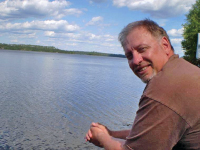Seizure-free now for 10 years, Daniel Horvath knows first-hand the difference brain surgery can make in the life of a person living with epilepsy.
Horvath has not had a seizure since undergoing an operation at the University of Western Ontario’s epilepsy clinic at London Health Sciences Centre to remove scar tissue from his brain in 2002, an event he characterizes as having changed his life.

Now 50, Horvath was diagnosed with epilepsy when he was 21. He says he’s “glad” he wasn’t diagnosed with epilepsy in his youth — in those days, he wouldn’t have been able to participate in sports, an important part of his life, he says.
“As I grew up, I played many, many sports: competitive swimming, water polo, volleyball, baseball, hockey, football, martial arts, boxing, cycling and motocross. In those days, I would never have been allowed to participate in any of those sports, period,” he says.
“Sports are what got me through school and created a drive. I would have been held back from many things in those days.”
By the time Horvath was in his 20s, his seizures had become more frequent and he ended up on an increasing number of seizure-control medications. Eventually, his seizure disorder caused Horvath to lose his driver’s licence, leaving him unable to drive for many years.
Horvath’s seizure disorder was, he says, dominating his life.
“I held back my seizure disorder from as many people as I could, (including) family and friends,” Horvath, the father of two sons, recalls.
By the time he reached his 30s, Horvath’s seizures were again increasing. By that time, the Internet was in full swing and Horvath began reaching out to the World Wide Web for information on seizure disorders, their cause and treatments.
It was around this time he sought additional help to find out more about his seizures and to see if there was an effective treatment. The operation was a success.
Enter neurologist Dr. John Paulseth.
When he connected with Paulseth, Horvath says the neurologist listened to him and, eventually, he was sent to the University of Western Ontario’s epilepsy clinic at London Health Sciences Centre for evaluation.
It was then doctors discovered the scar tissue on Horvath’s left temporal lobe that was causing his seizures. On Nov. 22, 2002, Horvath underwent surgery to remove the scar tissue.
Although he says the seizures could reoccur any time, Horvath has not had a single episode since the surgery.
“My life has been different ever since,” he says. “I am a very lucky man.”
If you have feedback on this story, or have a story of your own that you would like to share, please contact the newsroom at 800-294-0051, ext. 23, or e-mail deron(at)axiomnews.ca. You can also leave a comment below.
Writer: Deron Hamel






